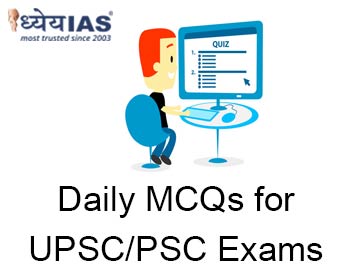Home > Daily-mcqs
Daily-mcqs 14 Apr 2025

Q1:
Consider the following advantages of long-range glide bombs: 1. They enable aircraft to strike targets without entering enemy airspace. 2. They are more expensive than cruise missiles but offer better accuracy. 3. They can be launched from fighter jets, bombers, or drones. How many of the above statements are correct?
A: Only one
B: Only two
C: All three
D: None
Answer: B
Explanation:
Statements 1 and 3 are correct. Glide bombs like ‘Gaurav’ offer standoff capability, allowing strikes without crossing into hostile territory, which reduces exposure to air defense systems. They are also platform-agnostic, deployable from fighter jets, bombers, and UAVs.
Statement 2 is incorrect; glide bombs are designed to be more cost-effective than cruise missiles. While a typical cruise missile can cost over $1 million, glide bombs are much cheaper yet still deliver high precision, with some achieving a Circular Error Probable (CEP) as low as 1–3 meters. This makes them ideal for frequent tactical and strategic use.
Q2:
Which of the following statements best distinguishes the Odisha Unified Health Insurance Scheme from the standalone Ayushman Bharat PM-JAY?
A: It limits annual health coverage to ₹5 lakh per family, excluding additional provisions.
B: It provides enhanced coverage for families that include women and senior citizens.
C: It is only available to families listed in the Socio-Economic Caste Census (SECC) 2011 database.
D: It restricts cashless treatment facilities to state-run hospitals within Odisha.
Answer: B
Explanation:
Unlike PM-JAY, which provides a uniform ₹5 lakh annual health coverage, the Odisha Unified Health Insurance Scheme introduces additional layers of support: ₹5 lakh extra for women beneficiaries and another ₹5 lakh for senior citizens aged 70 and above, bringing the total to ₹15 lakh for eligible families. It also expands the hospital network from 900 to over 29,000 empanelled hospitals across India. The scheme is not restricted to SECC 2011 data and does not limit treatment to government hospitals alone, making option (b) the correct, distinguishing feature.
Q3:
1. India has committed to achieving net-zero carbon emissions by 2050. 2. One of the targets is to reduce the carbon intensity of the economy by 45% from 2005 levels by 2030. 3. India aims to meet 50% of its total energy needs from renewable sources by 2030. Which of the above statements is/are correct?With reference to India’s ‘Panchamrit’ commitments, consider the following statements:
A: 2 and 3 only
B: 1 and 2 only
C: 3 only
D: All three
Answer: A
Explanation:
India’s Panchamrit goals, announced at COP26, include reducing the carbon intensity of its economy by 45% by 2030 (relative to 2005 levels) and sourcing 50% of total energy needs from renewables by 2030. These are Statements 2 and 3, both correct. However, Statement 1 is incorrect—India’s net-zero emissions target is set for 2070, not 2050. This aligns with India's developmental priorities and is consistent with its strategy of balancing growth and climate action. Therefore, option (a) is the right choice.
Q4:
Which of the following best explains the constitutional significance of the Supreme Court's ruling on Article 201?
A: It allows the President to reject state bills without providing any reason.
B: It sets a constitutional time limit for the Governor to assent to bills.
C: It introduces a time-bound mechanism for the President to decide on reserved state bills.
D: It removes the Governor’s power to reserve bills for the President.
Answer: C
Explanation:
The Supreme Court’s decision marks the first time a timeline (3 months) has been prescribed for the President to act on bills reserved by a Governor under Article 201. This addresses the issue of indefinite delays, which had previously allowed the Centre to postpone state legislation indefinitely without accountability. The court clarified that while the Governor can reserve a bill, the President must act within a reasonable period, and delays beyond 3 months must be justified in writing. This strengthens federalism and the legislative autonomy of states, making option (c) the most constitutionally significant statement.
Q5:
With reference to India's position in global automotive production, which of the following statements is correct?
A: India is the largest automobile producer in the world.
B: India is the fourth-largest automobile producer in the world.
C: India’s production exceeds 10 million vehicles annually.
D: India ranks 5th in the global automobile production.
Answer: B
Explanation:
India ranks as the fourth-largest automobile producer globally, following China, the USA, and Japan. With a production nearing 6 million vehicles annually, India has carved a significant space in both domestic and international markets. This positioning allows India to leverage cost-competitive labor and government initiatives like ‘Make in India’ to establish itself as a manufacturing hub. However, India's potential is constrained by challenges like low-value addition in high-precision components and limited technological advancements. India’s continued growth in this sector requires addressing infrastructure, operational efficiency, and innovation.